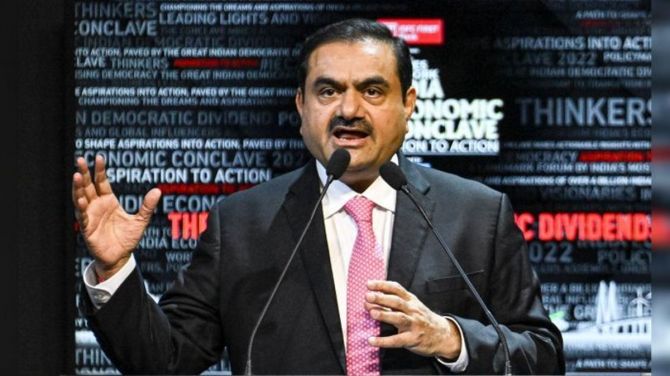Gautambhai has shown that he has ability to withstand payment delays or vexatious court cases. That is where he is on a more comfortable wicket than many others.
A revealing excerpt from R N Bhaskar's Gautam Adani: Reimagining Business in India and the World.

It is true that many of the businesses that Gautambhai is into are regulated businesses, where he may enjoy a natural monopoly.
This is true of power generation, transmission and distribution. It is true of roadways. Gas distribution too would also fall into the same basket.
But the big advantage about being in these businesses is that -- as mentioned earlier -- if your legal documentation is watertight, and the price purchase agreements are carefully structured, if you have the skills required for speedy implementation of projects (time is money) and the deal is signed, it becomes a bankable proposition.
The entrepreneur can now predict the rate of revenue flows into his coffers. The cash flows become long-term annuities.
The rates of return can increase if better efficiencies kick in.
He can use these cash flow projections to get money from the banks and also plan further diversifications.
And if he is Teflon-coated, most of the irritants of payment delays and court cases will just bounce off him.

This is important because governments are known to try renege on payments. It may take some time.
Many an entrepreneur has fallen by the wayside on account of such roadblocks.
But it is possible to make governments pay up eventually -- as has been the case in several disputes relating to power generation and power evacuation.
Government have also tried to renegotiate tariffs for solar power.
Eventually, no government can go against a well structured PPA.
It is worth recalling that even the much-maligned Enron project could not be cancelled because of the way the legal documents were structured.
Eventually, it was Enron's fall in the US that allowed the Government of India to enter into a negotiated settlement, for which too a very high price had to be paid.
An entrepreneur who has the ability to fight it out in courts, and also wait till there is a resolution, has a better chance of succeeding than one who has the right documentation, but does not have the financial strength to cope with delayed payments.
It is this kind of fragility that has done many politician-backed entrepreneurs in.
They may have had the right ideas and the right drive, but did not have the ability to withstand payment delays or vexatious court cases.
Good profits

Gautambhai has shown that he has both. That is where he is on a more comfortable wicket than many others.
This is where a study of the financials of both the 'stigmatized capital' beneficiaries become important.

Look at the Adani and Ambani charts above. You will notice the following points:
- The Adani Group has logged an unbelievably blistering pace of growth during the past twenty years.
- The Adani sales grew forty-two times during this period compared to twenty-four times for Ambani.
- Other income for Adani grew 585 times, compared to twenty-six for Ambani.
- Total income grew forty-seven times for Adani compared to twenty-four for Ambani.
- Interestingly, total borrowings for Adani grew a mindboggling 300 times during this period, compared to a modest ten times for Ambani.
Critics have talked about the unsustainability of such high growth in borrowings.
But they forget an old saying -- that it does not matter whether the money is borrowed or is your own money. Money must generate a decent rate of return.
It must generate profits that are higher than the commercial rate of borrowing.
This is again where Adani triumphs over Ambani.
Another interesting fact about the Adani Group is that its borrowings are not entirely from Indian banks.
Despite the large debt, borrowings from Indian banks are significantly lower than that for many other industrialists.
Thus the systemic risk to the Indian banking system is considerably less than that posed by many other Indian industrialists.

However, 'There has been a significant improvement in the group debt-servicing capacity in recent years due to a jump in group earnings. Besides, a general decline in interest rate in the economy in the last two years has resulted in muted growth in interest cost despite faster growth in borrowings.'
- Profit before interest tax and depreciation before adjustments (PBIDBA) for Adani grew 252 times. Ambani's PBIDBA grew fifteen times.

- Except for one year in FY2010, Adani's rates of return have been higher than those of Ambani.
In FY2021, return on capital employed for Adani was 14 per cent vs 9.4 for Ambani.
And returns on the CMIE definition of capital employed were 13.8 per cent vs 9.2 per cent respectively. - The one place in which Ambani trounces Adani, hands down, is on the foreign exchange earnings front.
Ambani's exports grew sixty-one times, while Adani's only two times (that too after adding Adani-Wilmar's export figures).

One reason for this could be the Adani Group's refusal to show forex earning and instead only shows net forex earnings.
In the port business, almost all the income is in foreign exchange. But there are foreign exchange expenses as well.
Adani has given the net figures which are exceedingly small.
This is where steel exports as well as defence exports, could provide the redeeming quality.
Another reason could be that most of the Adani Group's businesses are focused on domestic services, which do not allow for exports -- like the CGD or power distribution businesses.
But in this context, it must be stated that even though the Adani Group may not be a big exporter for now, his ports and airports enable exports and imports.
Without them, exports would have posed a big challenge.

And do watch the way Adani has used depreciation funds (which are essentially tax-free money lying with corporate managements) to finance his blistering rate of growth in addition to picking up debt.
It is a very interesting method of project financing. Adani's accumulated depreciation grew 8,454 times during these twenty years.
In this context, it is also relevant to quote an August 2022 Reuters report.
It points out, quite pertinently, 'While the amount borrowed across the listed companies has more than tripled to 2.3 trillion rupees ($30 billion) over the past decade, aggregate net debt has fallen to about 4 times EBITDA.
'He has diversified funding sources too, reducing his dependence on state banks, and extended the time available to pay off liabilities: 50 per cent of debt is in capital-markets instruments and repayments stretch from 2026 through 2046.
'Most of the group businesses, barring property and lending, are captured through listed entities where credit rating agencies see few obvious signs of weakness: Adani is buying cash-generating assets and its bidding behaviour for contracts or acquisitions is not considered aggressive.
When cashflows increase, and the rates of return are higher than the interest paid out, borrowing is not such a bad idea at all.'
Clearly, exports are the one front on which Adani will have to work extremely hard.
Excerpted from Gautam Adani: Reimagining Business in India and the World by R N Bhaskar with the kind permission of the publishers Penguin India.
Feature Presentation: Aslam Hunani/Rediff.com










